Ice: The Art of Hildur
Bjarnadóttir
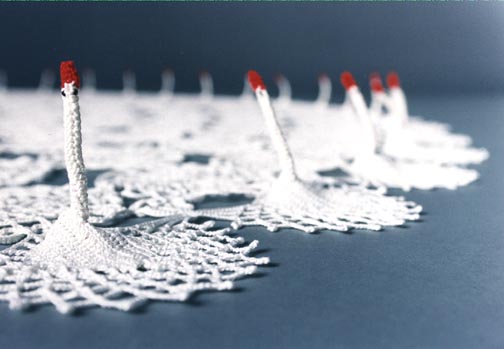
Hildur Bjarnadóttir
| Swanhildur (detail), 1997 | crocheted
cotton | 5" x 78" x 78"
Svan is Icelandic for
swan. Perhaps to honor her namesake bird,
Hildur Bjarnadóttir's grandmother
Svanhildur used to crochet little doilies,
each with five swans -- with long necks
and red beaks -- surrounding it. Today
her granddaughter's 6 1/2 foot version,
entitled Swanhildur, resides
in the permanent collection of the Reykjavik
Art Museum, "which is kind of nice,
the museum being located right next to
where my grandmother lived."
Family and tradition
are heavy influences in Hildur's work
-- which ranges from sweater-sized knitted
wall-hung works to enormous crocheted
doilies like Swanhildur and Shooting
Circle. Her 2002 piece entitled Yarn
Twirler consisted of a video loop
of Will Rogers constantly twirling his
rope around his horse. "The loop
is very meditative, echoing the feeling
I get when doing crocheting or other repetitious
work," says Hildur, and adds "Will
Rogers, by the way, was a real cowboy
who taught his children the dying art
of lassoing, just like my mother taught
me how to do handcrafts."
The artist remembers
knitting on her front lawn in Scotland
at the age of five. She soon took off
into creating her own patterns and sculptural
objects. "For as long I can remember
I have worked with this medium, long before
going to art school. It was a very natural,
effortless decision; nothing else was
really an option."
Even when she explores
the world of drawing and painting, she
does so with textiles, "drawing"
with graphite-colored yarn or unraveling
a painter's canvas and reworking it in
detailed crochet. In Wool Star,
the yoke of an Icelandic sweater is flattened
to become a bullseye painting. "I
simply wanted to make an un-functional
image based on that pattern -- easily
recognizable, but focused on the formal
or abstract elements."
Untitled (drawing)
is inspired by traditional Icelandic woolen
hats, knitted from the top-down. "The
hat begins with a little tip and then
you add loops from there gradually forming
the hat. I started out like I was making
a traditional hat but added more loops
than usual to make it stay flat. Where
I added a loop it makes a line, and makes
the whole into an intense drawing. I chose
a yarn which looks like graphite, it has
a little shine like when you draw intensely
with a pencil on a piece of paper."
Making
craft works
because
she loves
to, and
has to,
Hildur has
found a
ready and
willing
"fine
art"
audience.
Untitled
(drawing)
won a juror
award at
the 2001
Oregon Biennial
of the Portland
Art Museum.
With paintings
making up
a heavy
2/3 of the
exhibit,
understated
Hildur says,
"I
thought
it was enjoyable
to get a
prize for
a knitted
piece."
Hildur
is currently
working
on weaving
and tatting
-- more
decorative
work, which
she has
steered
away from
in the past.
"It
is very
important
for me to
keep a good
relationship
with Iceland,"
she says.
"Most
of my inspiration
comes from
my roots
there and
my upbringing, and a lot
of my work
relates
to Icelandic
and Scandinavian
textile
tradition.
I think
it suits
me best
to be able
spend half
my time
in America
and half
in Iceland."
Soon the
Pacific
Northwest
will be
treated
to her newest
work, when
their turn
at her affections
comes around
this summer.
Hildur
can be reached
via her
web site.
She is represented
by Pulliam
Deffenbaugh
Gallery.
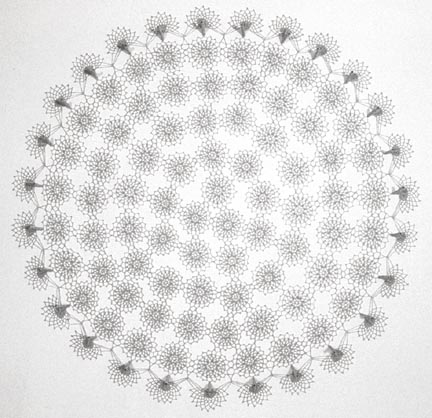
Hildur
Bjarnadóttir
| Shooting
Circle,
1998 | crocheted
silver yarn
| 4"
x 48"
x 48"
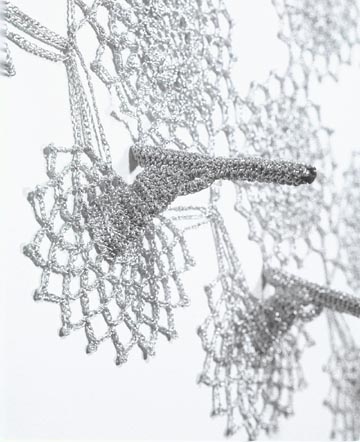
Hildur Bjarnadóttir
| Shooting
Circle (detail),
1998 | crocheted
silver yarn
| 4"
x 48"
x 48"
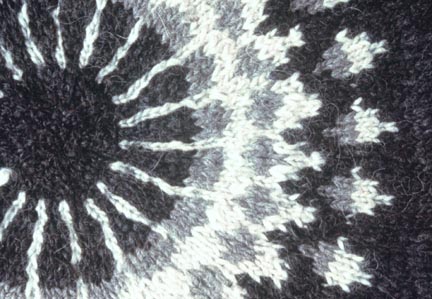
Hildur
Bjarnadóttir
| Wool Star
(detail),
1998| knitted
yarn| 26"
diameter

Heat:
The Art
of Shaza
"I
have a mother
lode of
lurex,"
says artist
Shaza. The
abandoned
yarn was
found in
an empty
knitting
factory
in Brooklyn,
after the
tenants
-- a company
that made
"icky
acrylic
sweaters"
-- moved
out. Artist
Michael
Yinger arranged
the yarn
into an
installation:
a 50' by
20' color
field. "When
he was finished,
I grabbed
what I could
get."
For
an artist
who paints
with yarn,
the find
was serendipitous.
With each
wall-hanging
sculptural
knitted
piece, Shaza
conveys
a color
and texture
story with
"fuzziness,
sparkle,
depth, things
tied to
it, tied
into the
work."
She knits
95% of her
art with
a "workhorse
of a 3-gauge
knitting
machine.
I've crammed
through
the most
incredible
combinations
to see what's
possible."
As she machine
knits, she
can only
see the
back of
the fabric
developing
until at
least a
foot is
finished,
so there's
always improvisation,
hope, and
surprise.
She washes
each knitted
piece in
hot water
to further
the surprise
through
distortion.
The works look
like landscapes, and indeed each one reflects
and is named for a place: Seattle,
San Diego, Naw'lins. But the artist
strives to keep away from anything representational.
Each piece is about color, texture, and
nostalgia. Color combinations will evoke
strong memories and emotions in viewers.
They want to touch Shaza's work, because
they have something in their past or their
home that it calls forth. A couch. An
old sweater.
The lurex became part
of Phoenix, an 18-foot-long monster
purple piece with which the artist has
a particularly dual relationship. "I
hate the color purple," she says,
"and Phoenix is not a destination
I enjoy." Phoenix was born
of the desire to hang something big off
the roof of her building for an open studio
event. "I made it out of hated colors
in case it was stolen or pigeons pooped
on it. But it came out a stunning piece."
Since then, Phoenix has been shown
wrapped around pipes, pooled in gallery
corners, and even used to swab the floor
at New York's CBGB.
It's
a good example
of how the
hanger --
and the
viewer --
complete
Shaza's
process.
Each piece
is malleable,
flexible,
open to
limitless
interpretation.
When shown
by a furniture
maker, they
can be laid
across tables
and sofas.
When shown
in a gallery,
they can
be hung,
precious,
on white
walls. In
much of
knitting
"everything's
geared toward
being something
when it's
finished.
But with
one of these
pieces it's
up to the
person who's
hanging
to decide
what it
is."
And
whether
it has a
purpose
at all.
Many say
knitted
art does
not. But
Shaza responds,
"It's
knitting
for knitting's
sake. It's
not supposed
to do anything."
Shaza
can be reached
via her
web site.

Shaza
| Naw'lins
| Mixed
fiber, tapestry,
beading,
sequins
and Mardi
gras beads

Shaza
| Palm Air
| Mixed
fiber, some
hand dyed
and spun,
paisley
print trim
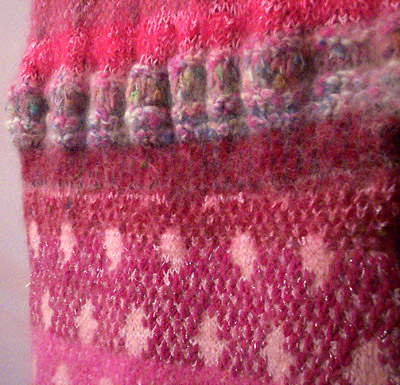
Shaza
| Palm Air
| Mixed
fiber, some
hand dyed
and spun,
paisley
print trim
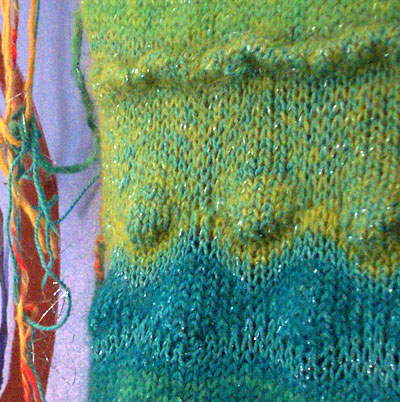
Shaza
| San Diego
| Mixed
fiber, some
hand dyed
and spun,
mini mirrors

